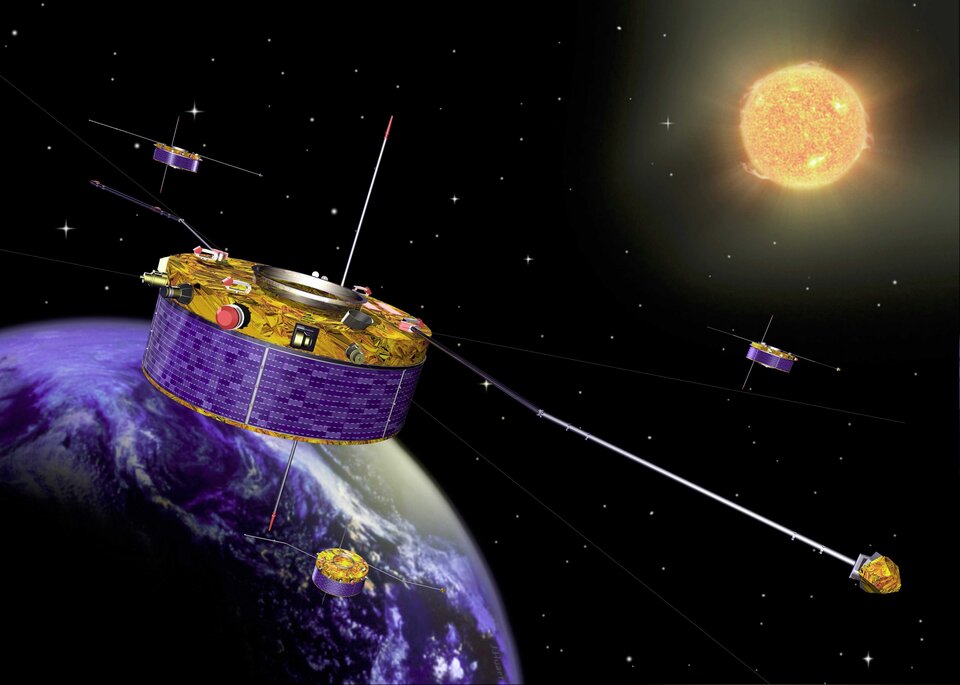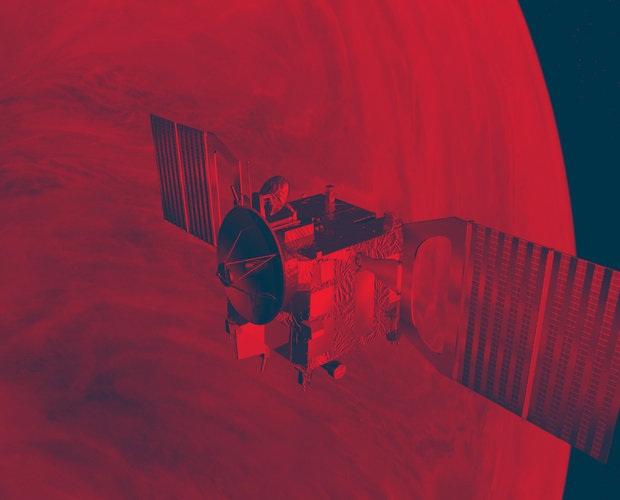ESA extends missions studying Mars, Venus and Earth’s magnetosphere
ESA’s Science Programme Committee has extended the operations of ESA’s Mars Express, Venus Express and Cluster missions until 31 December 2009.
The decision to extend the three successful missions was taken on 4 February this year.
Mars Express — global view of the Red Planet
Mars Express, launched in June 2003, has been orbiting the Red Planet since the end of 2003, and has produced a treasure of discoveries.
The first European mission to Mars, it has taken breathtaking, high-resolution images of the surface in 3D and in colour. The spacecraft carries the first radar instrument ever flown to Mars which has returned pioneering sub-surface sounding measurements that show underground water-ice deposits.
Mars Express has provided the first sub-surface sounding measurements thanks to the first radar instrument ever flown to Mars, and discovered underground water-ice deposits.
It has beamed back mineralogical evidence for the presence of liquid water throughout martian history and studied the density of the Martian crust in detail. It was also the first spacecraft to detect methane in the planet’s atmosphere from orbit.
The spacecraft pioneered the detection of aurorae at mid latitudes, provided estimates on the rate at which Mars’ atmosphere escapes into space, and studied the Martian moon Phobos at close quarters.
The mission has been extended twice in the past, the second extension lasting until May 2009. This third extension will make it possible to continue with the mission’s extensive study of the Red Planet which includes, amongst others: the study of its subsurface, the observation of the upper atmospheric layers under varying solar conditions, observation of methane in the atmosphere, and high resolution mapping of its surface.
Venus Express — lifting the veil on Venus

Venus Express was launched in November 2005 and reached Venus in April 2006, initiating the most comprehensive investigation of Earth’s sister planet to date. Its mission was extended once to last until May 2009.
Since it reached Venus in April 2006, Venus Express has been mapping Venus’s noxious and thick atmosphere globally and in 3D for the first time. With the data, scientists have put together extensive meteorological maps of Venus, providing measurements of wind fields and temperatures and the chemical composition of the atmosphere.
The spacecraft has revealed astonishing details of the planet’s dynamic cloud system, including its striking double-eyed atmospheric vortex that dominates the south pole.
Venus Express has also detected water molecules escaping into space, found concrete evidence for lightning in the venusian atmosphere, and provided infrared glimpses of the hot surface.
The new extension will provide, among other objectives, an improved understanding of how Venus’ climate works, and scientists will continue the search for suspected active volcanism on the surface.
Cluster — the Sun-Earth connection in focus

The Cluster constellation was launched in summer 2000 and started operating in early 2001. Since then, this four-satellite mission is performing the first and best ever stereo investigation of the Earth’s magnetosphere — the magnetic bubble surrounding our planet.
Thanks to Cluster, scientists have reached an unprecedented understanding of the way solar activity affects the near-Earth environment.
Cluster has provided the first 3D observation of magnetic reconnection in space — a phenomenon that reconfigures the magnetic field and releases high amounts of energy.
Cluster pioneered measurements of electric currents in space, revealed the nature of black aurorae, and discovered that plasma — a gas of charged particles surrounding Earth — makes ‘waves’.
The Cluster mission has been extended twice in the past, up to June 2009. The new extension will make it possible to study the auroral regions above Earth’s poles and widen the investigations of the magnetosphere — its inner region in particular.
For more information:
Fabio Favata, ESA - Head of Science Planning and Community Coordination office
Fabio.Favata @ esa.int















 Germany
Germany
 Austria
Austria
 Belgium
Belgium
 Denmark
Denmark
 Spain
Spain
 Estonia
Estonia
 Finland
Finland
 France
France
 Greece
Greece
 Hungary
Hungary
 Ireland
Ireland
 Italy
Italy
 Luxembourg
Luxembourg
 Norway
Norway
 The Netherlands
The Netherlands
 Poland
Poland
 Portugal
Portugal
 Czechia
Czechia
 Romania
Romania
 United Kingdom
United Kingdom
 Slovenia
Slovenia
 Sweden
Sweden
 Switzerland
Switzerland




























